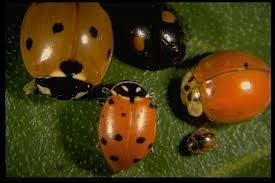Some homeowners may be seeing numerous lady bugs invading their homes this fall and winter. Lady beetles are insects that are considered beneficial and are not invading your home to cause problems, only to stay warm. The lady beetle does not chew or bore holes in walls nor do they eat carpet.
While they cause no harm, their overwintering inside people’s homes causes them to be somewhat of a nuisance.
Lady beetles are non-native insects that are considered one of our most beloved insect. The multi-colored Asian lady beetle is native to Asia but occurs in many areas of the United States. This beneficial insect was released in the United States as early as 1916. More lady bugs were released in the late 1970’s and early 1980’s. It has taken years for the populations to spread, but now large populations are found in many areas of the south, northeast, Midwest, and as far north as Oregon and Washington.
Lady bugs are also referred to as “lady beetles” or “lady bird beetles”. Adult beetles are orange with six small dark spots on each wing cover. The segment behind the head is black with a white margin and two convergent white dashes. The larvae are soft-bodied, gray and orange, and covered with rows of raised black spots.
The lady beetle is an effective and natural control for harmful plant pests such as aphids, scale, and other soft-bodied arthropods. One adult lady beetle may eat over 5,000 aphids during its lifetime.

The lady beetle also has a defense mechanism. If agitated or disturbed, the beetle’s reaction is to “reflex” bleed in which a yellow fluid with an unpleasant odor is released from the leg joints. This reaction helps prevent predators, such as birds, from eating the lady beetle.
This fluid can sometimes stain walls and fabrics.
The lady beetle is attracted to lighter colors such as whites, grays, and yellows. They enter homes through cracks and crevices. During warm winter days and early spring, the lady beetle may become more active searching for an exit.
No “control” of these beneficial insects is warranted. Prevent them from entering the home by caulking exterior cracks and crevices. Sweeping and vacuuming are effective means of removing these insects from the living area.
+++++++++++++++++++++++++++++++++++++++++++++++++++++++++++++++++++++
Cary Sims is the County Extension Agent for agriculture and natural resources for Angelina County. His email address is cw-sims@tamu.edu








